
* The Hunter was one of the mainstays of the frontline British RAF from the mid-1950s through the 1960s, and also served in training roles with the Royal Navy's FAA through that time. The type declined in numbers through the 1970s and the 1980s, with a few lingering in British service into the 1990s.
The Hunter was extremely popular in foreign service, flying with the air forces of 20 nations and seeing combat in a number of conflicts. This chapter surveys of the Hunter in British and foreign service.
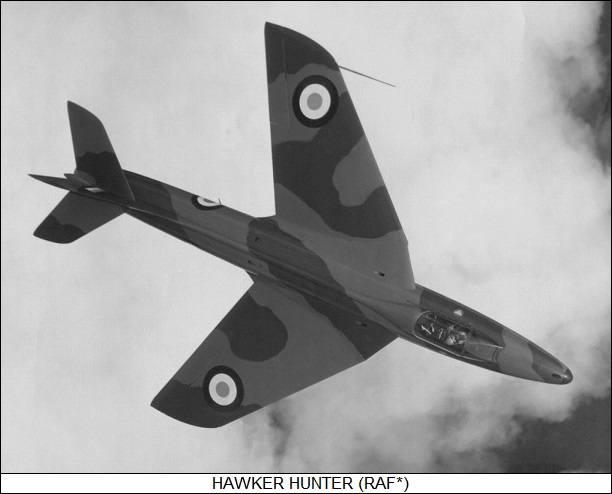
* The Hunter performed outstanding service for the RAF, at least once all the deficiencies were worked out with the Hunter F.6. The RAF had operated Canadair-built Sabres for a short time as an interim solution until the Hunter came into service, and RAF pilots found the Hunter a considerable improvement over their Sabres.
That was not too surprising, since the Sabre in general was about a half-generation behind the Hunter. If the Sabre was comparable to the Soviet MiG-15, the Hunter was comparable to the MiG-15's substantially improved follow-on, the MiG-17, in terms of capability and performance, and the Hunter was much more rugged than the Sabre. It seems plausible that the last of the Sabre fighter series, the muscular-looking and more powerful F-86H, was more in a league with the Hunter -- but the F-86H was not built in large numbers nor exported, and so that remains a subject of idle speculation.
The F.5 saw action during Operation MUSKETEER, the Anglo-French-Israeli seizure of the Suez Canal in the fall of 1956. Hunters flew from Cyprus to provide top cover for air strikes on Egyptian airfields and to provide air defense against Egyptian bombers.
The F.6, as such, does not appear to have seen much action with the RAF. However, in its time it was the preferred mount for RAF flight demonstration teams. The "Black Arrows" were formed in 1957 and at their peak flew 16 all-black F.6s. They made aviation history during the Farnborough air show in 1958, when Hunters from other units joined them to perform a double loop with 22 fighters, a record that at last report was still standing.
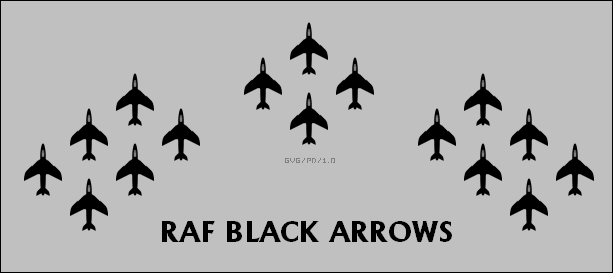
The Black Arrows were disbanded in 1961, but another Hunter demonstration team took over for the next flying season in the form of the RAF "Blue Diamonds", which featured up to 17 F.6s (plus one T.7) in spiffy dark blue colors with white trim. That wasn't the end of the British Hunter flight demonstration teams, either. In 1975, well after the heyday of the Hunter in British service, the FAA formed up an aerobatic team, the "Blue Herons", which was disbanded in 1980.
The Hunter FGA.9 was in action shortly after its introduction to service. In 1961, Iraq was making threatening noises about invading Kuwait, and so RAF Hunters were dispatched from Aden and Kuwait as a deterrent. The Iraqis decided not to invade -- they would change their minds in a few decades -- and the Hunters were withdrawn.
The Hunters stationed in Aden actually saw a fair amount of combat. An insurgency was in progress in Aden in 1962 and 1963, supported by Egyptian President Abdel Gamal Nasser, a fervent anticolonialist. The Hunters dropped leaflets, bombed insurgent installations, and provided air cover for British Special Air Service (SAS) commandos on raids into insurgent territories. The insurgency faded out in 1964; in 1967 the British gave up Aden, which became South Yemen and later merged with North Yemen.
The formation of the state of Malaysia in 1963 led to border clashes with Indonesia, with Hunters performing strikes on occasion and air patrols. British authorities made it publicly clear that intruders would be fired on, but there were apparently no shootouts between Hunters and Indonesian MiGs. However, there is a story that a Hunter got into a maneuvering contest with a MiG-17, which resulted in the MiG pilot flying his aircraft into the ground. If this actually happened, it was the only air-to-air kill of the Hunter in British service. The crisis fizzled out in 1965 when Indonesian leader Sukarno was overthrown in a savage coup.
* The Hunter had a strong career in British service, but in retrospect, with a little additional effort more could have been made of it. Part of the problem was that it was introduced into service at a time when Britain seemed determined to dismantle its aircraft industry, which had been in the front rank of aviation technology before the Second World War. The beginning of this sad process is generally traced to the issue in 1957 of a White Paper written by British Defense Minister Duncan Sandys (pronounced "Sands") that basically stated guided missiles were the way of the future and piloted aircraft were obsolete.
In Sandys' partial defense, that was not all that unusual a belief at the time, and it would take a while for people to understand that the guided missile technology they had was not close to mature enough to replace piloted aircraft, with the significant exception of the strategic (nuclear) strike role. It still isn't. It was also the case that the British Empire was entering its final phase of contraction at the time, the Suez Crisis of 1956 having done much to finally demolish British imperial ambitions, and there was a clear need to downsize and consolidate the British aircraft industry.
In the first ten years after the end of World War II, the Air Ministry had funded the development of a wide range of aircraft, in many cases fielding two different machines for the same requirement as "insurance", and that was a luxury that could no longer be afforded. The problem was that the downsizing was performed in an excessively drastic fashion, resulting more in a "crash" than a "soft landing". The British government axed many promising projects and did much to drag down the country's aerospace industry through the 1960s and into the 1970s.
The effect of the White Paper on the Hunter was that production tailed off quickly and plans for improved variants, such as the CFE Hunter, were filed away. Even fairly simple improvements to the type were neglected. One significant improvement would have been a "wet" centerline stores pylon, which would have allowed carriage of bombs on the inner stores pylons. This modification was actually performed on Singapore's Hunters, but it was implemented with assistance by Lockheed.
Similarly, several foreign users, including Chile, the Netherlands, Oman, Rhodesia, Sweden, Singapore, and Switzerland, wired up their Hunters to carry the US-built AIM-9 Sidewinder AAM, or foreign counterparts like the Israeli Shafir and South African Atlas Darter. Although Sidewinder variants available in the 1960s were of limited effectiveness, they still provided a significant improvement in air combat capability. The upgrade was straightforward, since the Sidewinder's seeker obtained a target lock on its own, indicating the lock to the pilot through a tone wired to the pilot's headphones. The RAF was promised Sidewinders for their Hunters, but never got them. While, as mentioned earlier, some Royal Navy Hunter trainers were wired for Sidewinders, no British Hunter ever carried them operationally.
The neglect of the Hunter in British service was also partly due to Hawker Siddeley's attempts to advance the case of their vertical take-off or landing (VTOL) fighter effort, in the form of the "P.1127" VTOL demonstrators and the subsequent "Kestrel" evaluation machines. The company hoped to develop a supersonic follow-on, the "P.1154", and didn't want to help create a distraction by improving the Hunter. The P.1154 effort was bogged down by squabbling between the RAF and the Royal Navy, to be eventually axed, but Hawker Siddeley was able to leverage some of the P.1154's kit into the Kestrel to create the Harrier jump-jet strike aircraft.
In any case, the single-seat Hunter was generally phased out of RAF frontline service in 1969, though it made a comeback in the mid-1970s as a conversion trainer for SEPECAT Jaguar pilots, and then made another comeback in the late 1980s and early 1990s in support of the RAF Blackburn Buccaneer force. The Buccaneer was grounded at one time due to airframe stress, and the Hunters were brought in to help aircrew keep up their flying time. Most of the Hunter trainers in British service were phased out with the introduction of the BAE Hawk trainer in the late 1970s, but both single-seaters and twin-seaters lingered on in small and dwindling numbers as evaluation machines and wotnot through the 1990s.
* Although the Hunter proved extremely popular in foreign service, the sad decline of Britain's aviation industry in the 1960s meant that as the Hunters grew old and were retired, aircraft from other nations replaced them. The US Northrop F-5 and the French Dassault Mirage 5 were popular "new recruits".
The decline of British aviation in the 1960s did not go without protest. 1968 was the 50th anniversary of the founding of the RAF, and no effort was made to perform an aerial display appropriate to the occasion. An RAF flight lieutenant named Alan Pollock was unhappy with this state of affairs and on 5 April took the matter into his own hands, flying his Hunter on a jaunt over London and then under the top span of the Tower Bridge. He then "beat up" several airfields with low-level runs, and landed to face the music. Pollock was summarily drummed out of the RAF, though in 1982 he would be at least partly exonerated on appeal. However wild his conduct, there were probably few RAF pilots who didn't sympathize with him.
BACK_TO_TOP* The Hunter was a very popular machine in foreign service. In 1954, both the Swedes and the Dutch came to Britain to evaluate the Hunter F.4.
On 29 June 1954, Sweden ordered 120 new-build F.4s as "F.50s" from the UK. This was the first export order for the Hunter. The Swedes were loaned an RAF F.4 for evaluation before delivery of their F.50s. The Swedish Air Force operated the Hunter as the "J 34", with the type equipping a total of four squadrons. A Swedish aerobatic team, the "Acro-Hunters", flew the Hunter in displays for a short time in the early 1960s.
Swedish F.4s featured a four-pylon wing without dogtooths, and were retrofitted with cannon link collectors plus muzzle blast deflectors. The Swedish Hunters featured an unusual and pleasing color scheme, with solid dark green on top and solid light blue-gray on the bottom. During the 1960s, most or all F.50s were wired to carry the Sidewinder AAM, built under license in Sweden, on the outboard wing pylons.
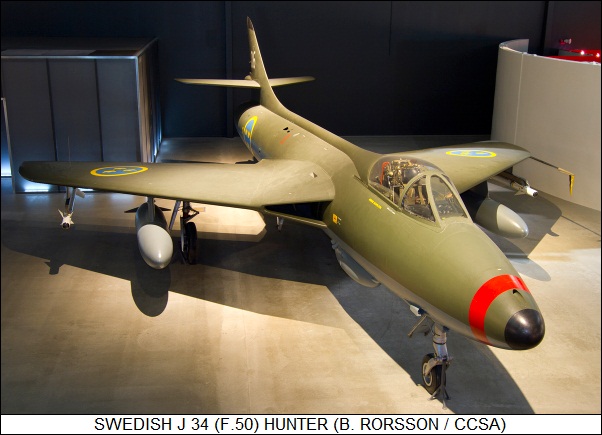
* On 3 July 1954, only four days after the Swedes closed their deal for F.4s, Denmark ordered 30 new-build F.4s as "F.51s". They received an initial evaluation RAF Hunter F.4 before delivery of their 30 F.51s, with the first F.51 arriving in January 1956. The Danes also obtained two "T.53" trainers in 1956, basically the same as the T.7 but not fitted with the dogtooth wing, and then obtained two T.7s from the Netherlands in 1968:1969. This gave a grand total of 35 Hunters, with at least 32 of them new-build.
The Danes operated a single squadron of Hunters. They were originally given RAF camouflage, but late in their careers they were painted olive-drab overall and given muted insignia. The last of them were withdrawn in 1974. One ended up in the Royal Danish Air Force Museum and 20 were sold back to Hawker Siddeley, but the Danes had got their money's worth out of their Hunters; they were too clapped-out to be worth refurbishing. Some were tidied up and put out to pasture as gate guards or museum pieces.
* The Dutch and the Belgians established a joint license-production arrangement that produced 96 F.4s and 93 F.6s for the Netherlands, and 112 F.4s plus 144 F.6s for Belgium. The first 48 Dutch F.4s and the first 64 Belgian F.4s were obtained with US defense-assistance funding.
The aircraft were built by Fokker in the Netherlands, and by SABCA and Avions Fairey in Belgium. Fokker built all the Dutch machines and some of the Belgian machines as well. The Dutch and the Belgians each got a single British-built F.4 as a manufacturing pattern aircraft in March 1955, incrementing the totals of F.4s by both countries by one. Their F.4s went into formal service in 1956, followed by the F.6s in 1957.
The Dutch also obtained 20 new-build T.7s directly from Britain, with initial delivery in 1955. The Belgians did not obtain any Hunter trainers themselves, since they had a training arrangement with the Dutch and used Dutch T.7s.
Dutch and Belgian Hunters were generally painted in RAF camouflage colors. The Belgians operated a demonstration team, the "Red Devils (Diables Rouges / Rode Duivels)" of red-painted Hunters from 1957 to 1963, but despite that they were really never enthusiastic about the type. They found the F.4's limitations too painful, and basically gave up on the Hunter without giving the improved F.6 serious consideration. Belgium phased out the last of their Hunters in 1963, selling most of them back to Hawker Siddeley at near-scrap prices. Many of the bought-back F.6s were new-condition aircraft with only a handful of hours of flight time.
The Dutch were not as unhappy with the Hunter; they even upgraded many of the F.6s with wiring for the Sidewinder AAM, carried on the outer wing pylons. Some sources claim some of the Dutch T.7s were also wired for Sidewinders. One of the T.7s was given a civil registration and used by the Dutch Flight Research Establishment for flight medicine studies. It was painted in a bright orange, white, and blue scheme to echo the Dutch flag. At least one of the F.6s was used for atmospheric radiation sampling, carrying a collection pod built from an external tank.
Dutch F.4s replaced Gloster Meteors in service. The F.4s were phased out in 1963, but the F.6s served until 1968, when they were replaced by the Lockheed F-104 Starfighter. Dutch Hunters were also sold back to Hawker Siddeley for refurbishment, and as mentioned two of their T.7s ended up in Denmark.
The buy-back of Belgian and Dutch Hunters would have a very positive effect on the future career of the type in foreign service. While the "recycling" of RAF Hunters was relatively limited, the ex-Belgian and ex-Dutch machines provide a generous stock of aircraft that could be refurbished and resold at attractive prices with good profit margins.
* The Swiss evaluated the Hunter in 1957 in a comparative flyoff in the UK against the F-86 Sabre and Folland Gnat. They liked the Hunter and performed a further evaluation in Switzerland using two machines on loan. They finally ordered 100 Hunter F.6s as the "Mark 58" in January 1958.
The first 12 of the batch were stock ex-RAF F.6s, while the other 88 were new-build machines, with initial delivery in 1959. The Swiss machines featured T.7-style brake chutes, Swiss-specified radios, and stronger outboard stores pylons that could carry 400-kilogram (880-pound) bombs. Apparently nose ballast had to be added to permit carriage of the heavier warload. The initial 12 F.6s, which were provided ahead of the production machines to get Swiss pilots up to speed on their new mounts, were returned to the UK for update to F.58 specification.
The F.58s were assigned the air combat role, with the attack role as a major secondary mission. From 1963, about half the Swiss F.58s were wired for carriage of US-built Sidewinder AAMs on the outboard pylons. The Swiss did not obtain any Hunter trainers initially, though they did borrow Hawker Siddeley's T.66 demonstrator for a while. Swiss Hunters were generally painted in standard RAF colors.
That was just the start of the Hunter's long and energetic career in Swiss service. As British aviation writer Jon Lake put it: "If the Hunter had not existed, the Swiss would have had to invent it." In the 1970s, the Swiss decided to obtain a replacement for their de Havilland Venoms in the attack role. They evaluated the McDonnell Douglas A-4M Skyhawk, the Northrop F-5A, the Fiat G.91Y, and the SAAB 105; decided to obtain the LTV A-7G Corsair II; then wavered and got into a competitive flyoff between the A-7G and the Dassault Milan derivative of the Mirage III/5 series fighter; and in the end decided to obtain 52 reconditioned single-seat Hunters as "F.58As", along with 8 "T.68" trainers!
Even this is a bit of an oversimplification of an obviously complicated process, because apparently the first 30 Hunters in the batch were ordered before the decision was made to give up on the A-7G and Milan. The A-7G was clearly a more effective strike aircraft, with precision navigation and attack avionics and a heavier warload; that was not too surprising, since it represented aircraft technology a generation beyond the Hunter and was designed from the outset for the strike role.
On the other hand, the Hunter was more affordable, even though in real terms the refurbished Hunters were more expensive than the original new-build Hunters obtained by Switzerland; and the Swiss were comfortable with the type, regarding it as reliable, rugged, useful, and economical to operate. In the balance they judged the trade-off of lower cost for lower capability as acceptable relative to their military requirements, and as it turned out they would take measures to squeeze a surprising amount of capability out of their Hunters.
The F.58As were delivered in kit form and featured the Avon 207 engine, not the Avon 203 engine used in the original F.58 batch. The older F.58s were refitted with the Avon 207. Incidentally, two of the F.58As had actually started life as two-seat T.7s! It is unclear what Avon variant was fitted to the T.68s, but simple maintenance and logistics considerations suggest they were fitted with Avon 207s as well. The trainers did have twin Aden cannons.
The T.68s were refitted with improved Martin-Baker ejection seats. They were not only used for conversion training, they were employed in the electronic countermeasures role, carrying a locally-built T-708 pod on an outboard pylon that contained an RF jammer in the front and a chaff-flare dispenser in the back. The right-hand seater controlled the countermeasures gear.
The Swiss later acquired the Northrop F-5E Tiger II, most of them built under license, which took up the air-superiority role, and the Hunters were reassigned to the strike role. The Swiss performed credible upgrades to keep the Hunters effective. From 1974, the single-seaters were fitted with the SAAB BT-9K bombsight, which had been used on Swiss Venoms, except for 12 Hunters that were set aside as target tugs for their primary mission. The target tugs were fitted with a locally-built tow / winch unit that was carried on an inboard stores pylon. Some sources claim that T.68s were fitted with the BT-9K bombsight and were even wired for Sidewinders, but this seems slightly implausible.
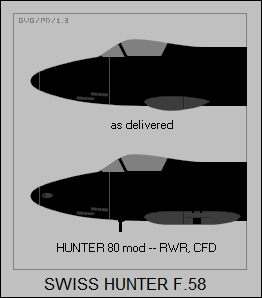
The most elaborate upgrade was provided by the "Hunter 80" program in the early 1980s, which included fit of a US-built AN/APR-9 radar warning receiver (RWR), with antennas on the nose, and US-built AN/ALE-39 chaff-flare dispensers, built into modified cannon link collector bins. Another rocket-launch rail was added under each wing, raising the total from 8 to 10. All front-line aircraft were also qualified to carry the devastatingly effective British Hunting Engineering BL755 cluster bomb, and 40 were configured to carry the highly accurate US-built AGM-65B Maverick electro-optic air-to-ground missile. Some sources claim that Swiss Hunters also carried laser-guided bombs, with target designation provided by ground troops.
The Maverick carriage was a bit of a puzzle, since the Maverick uses a video seeker that requires the pilot to get an initial target lock using a cockpit video display. It is unclear if there was an existing display in the Hunter cockpit that could be used for this purpose or if a new display was fitted, though pictures of the F.58's cockpit do show it to have a number of improvements.
There was a certain irony in Hunters carrying Mavericks since the missile represented a much more advanced level of technology than the aircraft carrying it, but it was a tribute to the utility of the Hunter that it could be adapted to the times and remain effective. The Swiss may not have invented the Hunter but they certainly re-invented it, which both demonstrated the machine's excellence -- as well as the certain frustrating amount of neglect it suffered in RAF service.
Incidentally, apparently a portion of the Swiss Hunter fleet was held in reserve as "sleeper squadrons", with the aircraft stowed in special hangars that were dug into the sides of mountains. The aircraft were suspended from the ceiling on cables, and as far as sketchy accounts go they would use special sections of roadway for take-offs and landings if it came to a shooting match.
* Swiss Hunters did not see any combat, but one reputedly did score a "kill" -- on another Hunter, in an accident during a live-fire exercise. The other pilot ejected unharmed, and the story has it that the offending Hunter actually carried a "kill" marking for a time. Whether this was out of a dark sense of humor or as a "dunce cap" for the pilot is unclear.
The very first new-build F.58 delivered was put straight into service with the "Gruppe fuer Ruestungdienste", a civilian test organization, and remained there for the rest of its career. It retained its RAF colors along with bright dayglow red edging around its wing, along its spine and tailfin, and on its nose, plus camera-calibration circles divided into black and white quadrants alongside nose and tail and an oversized bright gentian violet painted underneath.
Swiss Hunters were the mount for the "Patrouille Suisse" flight demonstration team, with their aircraft fitted with smoke generators that fed diesel and dye into the engine exhaust. The group was formed in 1960 and flew four machines at that time, went to five in 1970 and then six in 1978. They originally flew in standard colors, but later featured an imaginative red-and-white color scheme on their bellies.
The last Swiss Hunters were phased out of service in 1994. That was a year earlier than initially planned, but the Hunters were becoming too expensive to maintain. Towards the end of their time, some were given very interesting color schemes, the most striking being the "Paper Plane" of Fliegerstaffel (Squadron) 15. This machine was painted all-white and marked with the squadron and aircrew names in nice typewriter fonts, and the left underwing Swiss insignia featured a white cross modified to look like a paper airplane.
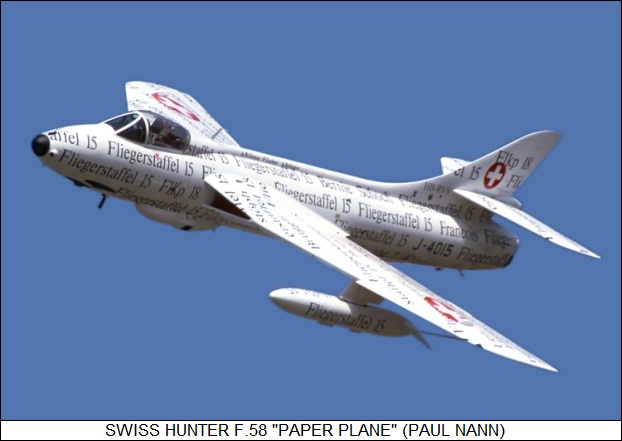
Of the 160 Hunters in Swiss service, 26 were lost in accidents, killing 15 aircrew, not such a bad record for 36 years of service. Originally all the Swiss Hunters, except for a handful to be donated to museums or used for gate guards and the like, were to scrapped in accordance with strict Swiss rules about exporting weapons. However, there was a loophole in the law in that while Switzerland could not sell the aircraft, they could be given away, and dozens of Swiss Hunters ended up in private hands. It was actually cheaper to give them away than scrap them, though it seems likely the end users had to cover costs associated with the transfer.
14 Swiss Hunter F.58s ended up back in a military role of sorts, by the US Airborne Tactical Advantage Company (ATAC), which provides adversary training services for the US military. The ATAC Hunters specialize in representing aerial threats for the crews of US Navy vessels.
BACK_TO_TOP* The Hunter was very popular in Middle Eastern service. Abu Dhabi obtained seven Hunter FGA.9s as "FGA.76s", three FR.10s as "FR.76As", and two T.7s as "T.77s", delivered in 1970:1971. They were originally operated by RAF pilots on detached duty until Abu Dhaban pilots were trained to pilot them, and flew defensive patrols in a long-standing border dispute with Saudi Arabia. The aircraft were painted in a sand-and-brown desert camouflage pattern.
During the 1970s, Abu Dhabi obtained a fleet of Mirage 5s and relegated the Hunters to the ground-attack role. They were then finally phased out in favor of the BAE Hawk in 1983, with the surviving Hunters passed on to Somalia. Some sources claim that both T.77s were passed on to Jordan in 1975, but since at least one T.77 ended up in Somalia, that seems a little implausible.
* Iraq obtained an initial batch of 15 Hunter F.6s from RAF stocks with American funding, the first aircraft arriving in 1958. They followed this batch up in 1963 with 24 "FGA.59s", which were ex-RAF F.6s updated to FGA.9 standard, and then 18 identical "FGA.59As" in 1965:1966. In addition, after borrowing the Hawker trainer demonstrator for about a year, they obtained five T.66s as "T.69s" in the 1963:1965 timeframe, followed by four FR.10s as "FR.59Bs".
Sources variously give the Iraqi T.69s as "T.59s", "T.60s", or "T.66As", with some of the sources dancing back and forth between these designations. It is possible that the trainers had multiple designations. In any case, Iraq obtained a total of 57 Hunter fighters, 5 Hunter trainers, and 4 Hunter fighter-reconnaissance machines.
Iraqi Hunters fought in both the Six-Day War in 1967 and the 1973 Yom Kippur War, serving in both air-to-air and ground-support roles. The Israelis claimed a number of kills on Iraqi Hunters during these conflicts, while Iraqi Hunters claimed a number of kills on Israeli machines. The actual facts of the case seem almost impossible to sort out with any conviction. It is known that Jordanian pilots, whose Hunters were mostly shot up on the ground by the Israelis, did fly Iraqi Hunters during the Six-Day War, and other foreign pilots flew Iraqi Hunters during both conflicts as well. One Pakistani pilot, Flight Lieutenant Saiful Azama, who had been on exchange with the Jordanian Air Force when the war broke out, claimed six kills on Israeli Air Force aircraft in the conflict.
Iraqi Hunters were phased out of service during the 1970s in favor of the Sukhoi Su-7, but they may have participated in strikes against the Iranians during the Iran-Iraq War in the 1980s, possibly dropping chemical munitions. They were certainly out of service by the time of the Gulf War in 1991.
* Jordan obtained an initial batch of 12 Hunter F.6s in 1958, followed by 12 ex-RAF FGA.9s in 1962, and then eight ex-RAF F.6s refurbished to FGA.9 standard as "FGA.73s". They also obtained three "T.66B" trainers in 1960, and two FR.10s in 1960:61. Apparently one of the FR.10s was modified from an F.6 and lacked the brake chute; it is referred to as an "FR.6" in some sources.
King Hussein of Jordan, a skilled pilot, is believed to have checked out on the single-seat Hunter, and in 1964 the Royal Jordanian Air Force formed up a nine-aircraft Hunter flight demonstration team, the "Hashemite Diamond". Jordanian Hunters claimed a number of kills against Israeli aircraft in 1964 and 1966, but all the country's Hunters were destroyed or shot up by the Israelis during the 1967 Six-Day War. As mentioned, Jordanian pilots flew Iraqi Hunters during that conflict.
After the war, Jordan rebuilt their Hunter force, first receiving three hand-me-down Saudi F.6s and four ex-RAF FGA.9s. Jordan then obtained two batches of refurbished Hunters, including 12 "FGA.73As" and 3 "FGA.73Bs", delivered between 1968 and 1971. The Jordanian Hunter force was then quickly phased out in favor of the Northrop F-5E and the Cessna T-37. 31 Jordanian Hunters were passed on to Oman. Since that sum well exceeds the number of Hunters obtained by Jordan after 1967, it seems likely that a good number of the aircraft shot up in the Six-Day War were returned to service, possibly by consolidating multiple wrecks.
* Kuwait obtained four Hunters refurbished to FGA.9 spec as "FGA.57s" in 1965, acquiring two more later, plus five F.6s converted to a T.66 trainer configuration as "T.67s". The single-seaters were phased out in favor of American Douglas A-4 Skyhawks in 1976, but the surviving T.67s remained in service until 1980. Some sources claim some or all of the T.67s were passed on to Oman. Two of the T.67s are known to have ended up in Chile in the early 1980s, but it is unclear if they saw service in Oman first.
* Lebanon obtained six ex-RAF Hunter F.6s in 1958:1959 using American funding. In 1960s, they obtained four FGA.9s as "FGA.70s" and three "T.66Cs" with the Avon 203 engine, followed by six "FGA.70As" in the mid-1970s. All retained RAF colors. It appears that Lebanese Hunters engaged in very little combat with the Israelis, but did see action in the Lebanese Civil War in the 1980s. Some were still flying in the late 1990s; they were grounded for a time, but four were refitted for flight from 2007, though they were finally grounded for good in 2014.
* Oman apparently obtained a number of ex-RAF F.6s, and then as mentioned received 31 hand-me-down Hunters from Jordan in 1975. Some sources claim a few Kuwaiti T.67s ended up in Oman as well. Only 15 of the aircraft provided to Oman ended up on flight status, with the others being used as spares hulks. While they were generally delivered in RAF colors, apparently they ended up in a range of color schemes, with some in desert camouflage, some in pale air-superiority colors, and so on. At least some were wired for Sidewinder carriage.
It appears that the Omani Hunters were flown by RAF pilots on detached duty and (mostly ex-RAF) mercenaries. The Hunters were used in border squabbles with Yemen in 1975, with one shot down, one damaged beyond repair, and a few others damaged but repairable. The last Omani Hunters were withdrawn from service in 1993.
* In 1971, Qatar received three Hunter FGA.9s as "FGA.78s", identical to the Abu Dhabi FGA.76, and a single T.7 trainer as the "T.79". These machines were painted in a desert camouflage scheme and flown by RAF pilots on detached duty. The Hunters were replaced by six Dassault-Dornier Alpha Jets during the 1980s or early 1990s.
* Saudi Arabia obtained four Hunter F.6s under the designation "F.60" and two T.66 trainers, which some sources claim were designated "T.70", in the "Magic Carpet" arms deal in 1966. Their primary purpose was to provide a transition platform for Saudi pilots moving up from the BAC Strikemaster to the English Electric Lightning, which was the centerpiece of the deal.
The Hunters arrived well before the Lightnings and they saw some action in squabbles between Egypt and Saudi Arabia not long after their arrival. One of the Saudi Hunters was lost in an accident in 1967 and the other three were passed on to Jordan in 1968. The two T.70 trainers were returned to Hawker Siddeley in 1974.
* African Hunter users included Kenya, Rhodesia (later Zimbabwe), and Somalia. Rhodesia obtained 12 ex-RAF FGA.9s in the mid-1960s. Rhodesia unilaterally declared independence from Britain in 1965 and Britain shut off spares supplies, but the Rhodesians apparently had little problem keeping their Hunters in the air. At least some were later wired for carriage of the South African Atlas Darter AAM, another heat-seeker in a class with the Sidewinder.
The white-supremacist government used them in strikes against black insurgents. Rhodesian aircraft carried RPs; napalm tanks; cluster bombs filled with "flechettes" (small metal darts); and the "Golf" bomb, which was a 450-kilogram (1,000-pound) blast-fragmentation munition fitted with an extended "daisy cutter" fuze. Since the insurgents were generally operating from sanctuaries in neighboring states that meant strikes across borders, and in some cases Rhodesian Hunters flew over local airbases, asking the control tower politely to not send up any opposition -- and adding that if anything tried to take off to intercept, it would be shot down.
Two Rhodesian Hunters were lost up to the political settlement of the conflict in 1979, leading to the formation of the modern state of Zimbabwe in 1980. In 1981, Zimbabwe bought four FGA.80s and a T.81 from Kenya.
The fighting didn't die out right away. Nine Hunters were lost in an insurgent attack on their ground base in July 1982. To rebuild the fleet, Britain provided five FGA.9s in 1983 and four more in 1987. Given the dysfunctional nature of the Zimbabwean state by the turn of the century, it seems unlikely any are still flying.
* In 1974, Kenya obtained four Hunter FGA.9s as "FGA.80s" and two T.7s as "T.81s". The FGA.9s were ex-RAF machines. It is unclear if the T.81s were ex-RAF T.7s or, as their designation hints, ex-FAA T.8s. One trainer was lost in an accident. These survivors were replaced by Northrop F-5s in 1979, and as mentioned sold to Zimbabwe in 1981.
* Somalia is believed to have received a number of Hunters from Abu Dhabi in 1983, some sources claiming six, including five FGA.76s and a T.77; and others claiming nine, including seven FGA.76s, one FR.76A, and a T.77. The Hunters were used in a nasty little border war between Somalia and Ethiopia, and were flown by South African and Rhodesian mercenaries. The breakdown of civil order in Somalia in 1991 ended up grounding the Somali air force. Pictures were taken of several Somali Hunters in 1993, showing them to be in sadly dilapidated and totally unflyable condition.
BACK_TO_TOP* Asian Hunter users included India and Singapore. A delegation from India visited Hawker in the UK in 1956 to consider purchase of either the Hunter F.4 or the F.6. Not surprisingly they chose the F.6, ordering 182 in 1957, including 160 "F.56s", which were F.6s with cannon muzzle blast deflectors and brake chutes; and 22 T.66 trainers, with the Avon 203 engine.
The first 16 F.56s were actually F.6s obtained directly from RAF stocks, which were modified to F.56 standard after delivery to India. The remaining F.56s were delivered from Hawker. Initial delivery of the F.56 to India was on 11 October 1957, with the type going into squadron service at the end of the year. The first T.66s were delivered in February 1959. By the end of 1961, Indian Air Force (IAF) Hunters were up to strength, equipping seven squadrons. They were generally painted in standard RAF green / dark gray / light gray colors.
Indian Hunters are believed to have participated in the Indian occupation of Goa in 1961, mostly as a show of force, and may have tangled with Chinese MiG-17s during border squabbles in the early 1960s. Details are unavailable, but given the close match of capabilities between the Hunter and the MiG-17, it would seem an interesting contest.
Indian Hunters saw their first major combat service during the Indo-Pakistan war of 1965, when they were mostly used in the ground-attack role. In a famous incident, a Pakistani pilot, Squadron Leader Alam at the controls of a North American F-86 Sabre, claimed five kills on Hunters in a matter of minutes, but Indian sources contradict his story.
Apparently two Indian Hunters were "bounced" by two Pakistani F-104 Starfighters, which were much faster than the Hunters, but nowhere near as maneuverable. The Hunters simply evaded their attackers until the Starfighters ran low on fuel. In any case, the box score at the end of the conflict of Hunters versus Sabres was at least even, as far as anyone can make out.
The IAF obtained additional batches of refurbished Hunters after the 1965 war. Single-seaters were obtained in the form of "FGA.56As", which were basically FGA.9s, with 36 ordered in 1965, 11 in 1967, and 6 in 1968. Two more batches of two-seaters were ordered as well, including 12 "T.66Ds" in 1968 and 5 "T.66Es" in 1973. An unknown number of IAF Hunters were locally upgraded to FR.10 specification, with the camera nose.
Hunters flew combat operations again in the 1971 Indo-Pakistan war that resulted in the creation of the state of Bangladesh. The Hunters performed close-support sorties and a number were lost. Hunters began to be replaced by the MiG-21 in the early 1970s in the air-combat role and by the SEPECAT Jaguar in the late 1970s -- but the Hunter lingered in second-string roles for a long time, flying as advanced trainers and target tugs. A few target tugs were said to still be in service as late as 1999.
The Hunter was used by the Indian Air Force "Thunderbolts" flight demonstration team, which was formed in 1982 as part of the IAF's Golden Jubilee and was disbanded in 1988. These machines were painted in a spiffy color scheme, painted dark blue with white lightning bolts.
* Singapore operated a substantial number of Hunters, including:
That gave Singapore 12 FGA.74s, 26 FR.74A/Bs, and 8 T.75/As, for a total of 46 Hunters. All were of course rebuilds of older Hunters. Some Singaporean Hunters were updated with a centerline stores pylon, implemented by Lockheed and mentioned earlier; and some were wired to carry Sidewinder AAMs on a new inboard pylon. At least two of the Singaporean trainers were painted in spectacular sharkmouth colors, complete with eyes and even gill slits.
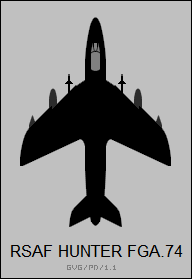
The last Hunters in Singapore service were phased out in 1992, being replaced by the General Dynamics F-16 in the fighter role and the Northrop RF-5E TigerEye in the reconnaissance role. The 21 survivors of the fleet were sold to an Australian warbird broker in 1995.
* Latin American users of the Hunter included Chile and Peru. Chile had hoped to obtain 25 F-86Fs from the US in the mid-1960s, but the deal fell through and they turned to the Hunter, which was superior to the Sabre anyway. The Chilean Air Force (FACH in its Spanish acronym) obtained a series of initial batches of Hunters from 1968 through 1974 that included 28 FGA.9s as "FGA.71s"; six FR.10s as "FR.71As"; and five T.66s as "T.72s"; for a total of 39 Hunters. These machines were mostly rebuilds, but included the second Hunter trainer prototype and the Hawker company demonstrator.
Chilean Hunters saw combat during a September 1973 coup that evicted the country's Leftist civilian government for a Rightist military government. The new government became notorious for human-rights violations, Britain suspended spares deliveries for a time, and the FACH Hunter fleet found itself increasingly grounded.
The military gradually relaxed its grip on the government beginning in the late 1970s, with Britain then resuming shipments of spares. In 1982, during Britain's retaking of the Falkland Islands from Argentina, Chile apparently allowed British Canberras in Chilean markings to overfly Argentina and provided a number of other services to discreetly help the British win their "splendid little war". In any case, as a reward the Chileans were given 12 ex-RAF FGA.9s, apparently mostly for use as spares hulks, and also received two Kuwaiti T.67s, possibly by way of Oman.
In the early 1980s, surviving Chilean FGA.71s were given the "Aguila" upgrade, implemented by the Chilean firm ENAER, featuring a locally-built Caiquin radar warning receiver, with an antenna mounted on the top of the tailfin; chaff-flare dispensers; and improved cockpit instrumentation. Since the Hunters were also wired for Israeli Shafir AAMs, it seems plausible the upgrade was performed with Israeli technical assistance.
The FACH liked their Hunters very much and were interested in acquiring new Hunters as late as 1994. They couldn't do so, so they acquired the Dassault Mirage 5 instead, with the last FACH Hunters phased out in 1995.
* Peru was an early adopter of the Hunter, acquiring 16 "F.52s" in 1956. These were completely stock F-4s with the two-pylon wing. The F.52s were apparently new-build machines, but the truth seems to be a bit ambiguous because most were ordered by the RAF but not delivered to that service.
The Peruvians obtained a single T.7 under the designation "T.62" in 1960, with this aircraft featuring a radio compass in a blister just behind the cockpit. Peru considered acquiring F.6s in 1966 but decided to obtain the Dassault Mirage 5 instead, relegating the Hunters to the ground-support role in 1968 despite the two-pylon wing. They were replaced in this role in turn by the Sukhoi Su-22 in 1976, but ten single-seat Hunters remained in the advanced training role after that, being finally phased out along with the T.62 trainer in 1980.
* The following lists give a condensed summary of Hunter production, glossing over many of model numbers given to second-hand machines for export. Single-seaters included:
Two-seaters included:
* Given the large numbers of Hunters built and the type's ruggedness, it is no surprise that dozens are still flying as privately-owned "warbirds" all around the world. The phaseout of the Swiss Hunters was a particular treasure for warbird collectors. While many privately-own Hunters are painted in military colors, some sport wild color schemes to help "wow the crowd" at airshows.
As with any aircraft that was built in large quantities, to be sold and resold to a lot of users, trying to track down correct numbers such as actual production quantities and who obtained how many of what variant is a real nightmare. The numbers given here have to be regarded as reasonable approximations that are certainly in the ballpark. I think I would laugh at anyone who told me they were absolutely certain of all the exact details: "I don't think so."
* Sources include:
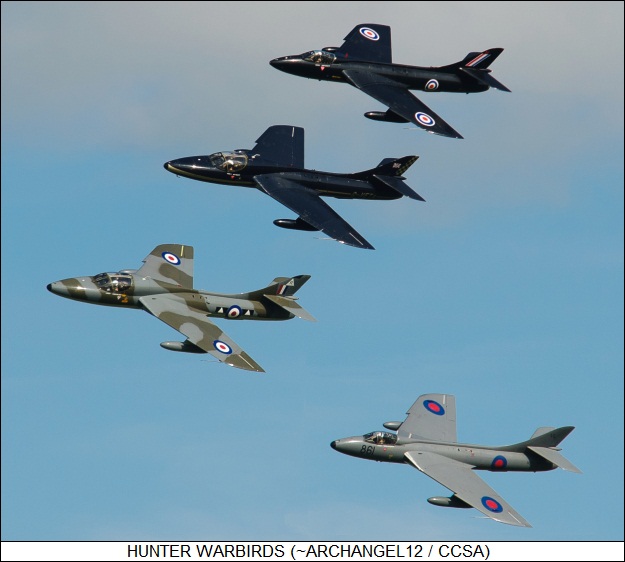
* Revision history:
v1.0.0 / 01 jun 03 v1.0.1 / 01 jun 05 / Review & polish. v1.0.2 / 01 jan 07 / Review & polish. v1.0.3 / 01 jan 09 / Review & polish. v1.0.4 / 01 dec 10 / Review & polish. v1.0.5 / 01 nov 12 / Review & polish. v1.0.6 / 01 oct 14 / Review & polish. v1.0.7 / 01 sep 16 / Review & polish. v1.0.8 / 01 aug 18 / Review & polish. v1.0.9 / 01 jul 20 / Review & polish. v1.1.0 / 01 may 22 / Review & polish. v1.1.1 / 01 apr 24 / Review & polish. (++)BACK_TO_TOP
